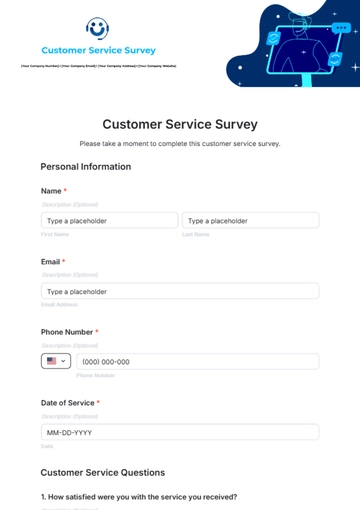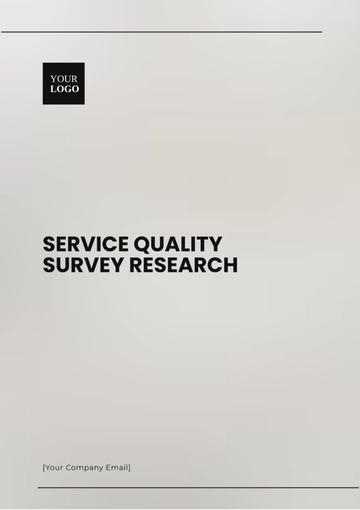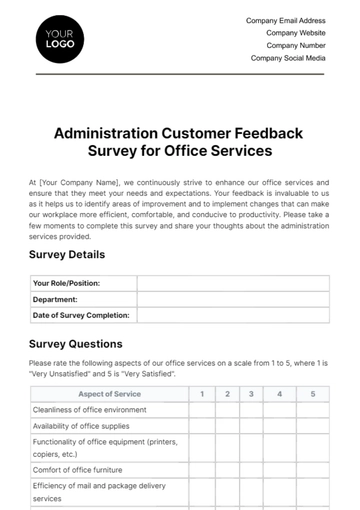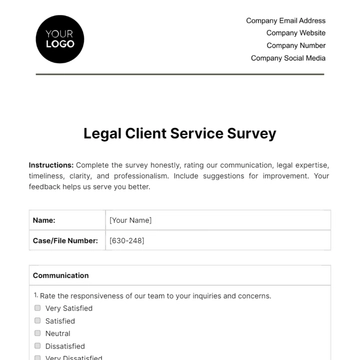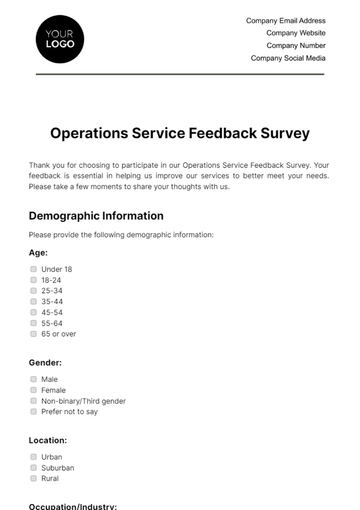Free Service Quality Survey Research
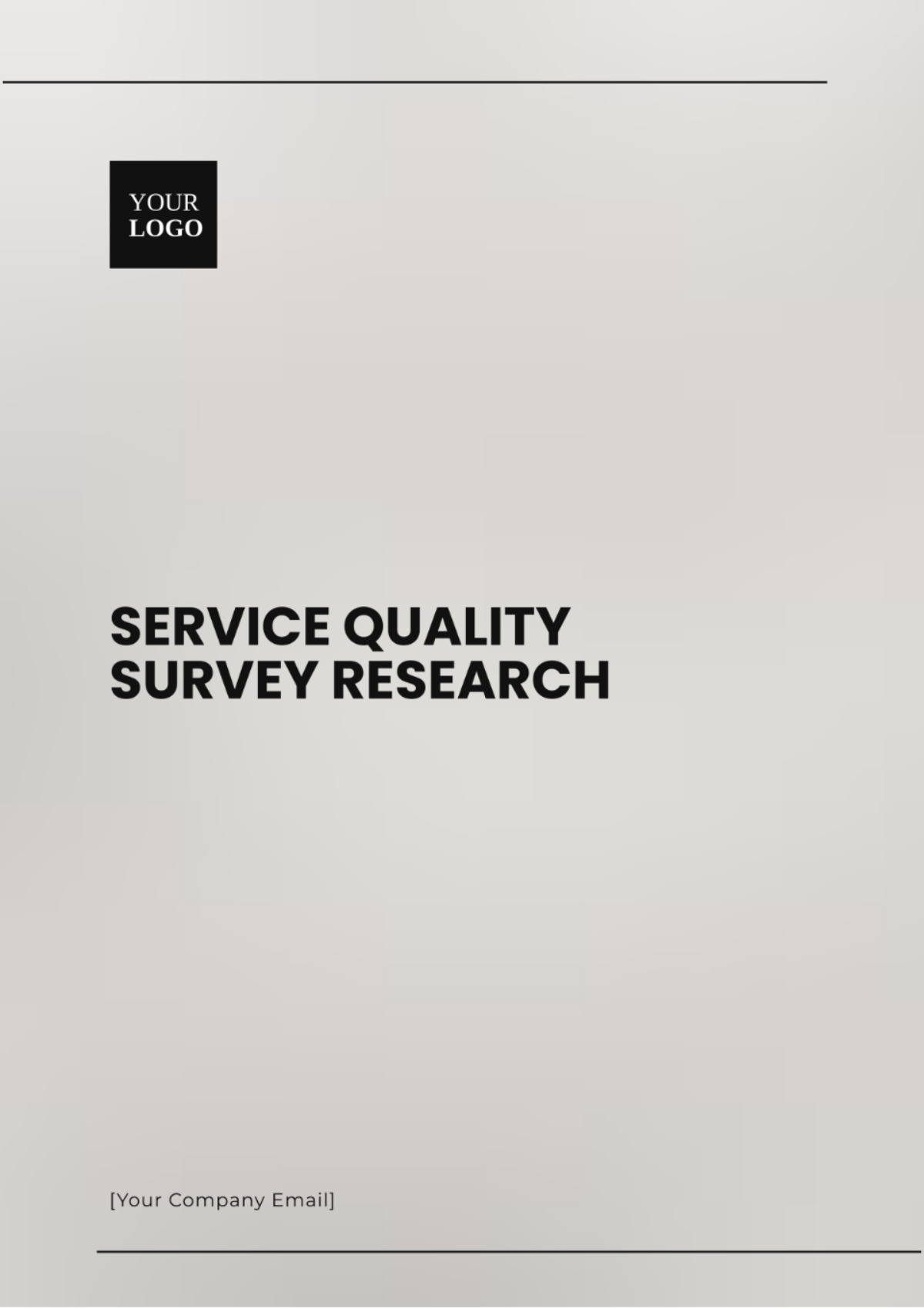
Prepared By: [YOUR NAME]
Date: [DATE]
I. Introduction
The purpose of this Service Quality Survey Research is to measure and evaluate customers' perceptions of service quality within a specific organization. This structured study aims to gather direct feedback from customers regarding their experiences with the company's products or services, focusing on factors such as timeliness, efficiency, and overall satisfaction. The data collected will be analyzed to determine how well the company meets customer expectations and identify areas for improvement.
II. Demographics
Information about the respondents was collected to provide context for the survey results. The demographics include age, gender, and location, which help in understanding the diverse backgrounds of the respondents and tailoring the analysis accordingly.
Age Group | Percentage |
|---|---|
18-25 | 20% |
26-35 | 35% |
36-45 | 25% |
46-55 | 15% |
56+ | 5% |
Gender | Percentage |
|---|---|
Male | 50% |
Female | 48% |
Other | 2% |
Location | Percentage |
|---|---|
Urban | 60% |
Suburban | 30% |
Rural | 10% |
III. Service Attributes
The survey included questions on specific service attributes to assess various dimensions of service quality:
Responsiveness: The capacity of the company to deliver services swiftly and efficiently, as well as their competence in addressing and resolving customer inquiries promptly.
Reliability: The reliability in the performance of tasks and the steadfast dependability of the service being provided.
Assurance: The employees' depth of knowledge, their unfailing courtesy, and their remarkable ability to effectively convey a sense of trust and instill confidence.
IV. Customer Satisfaction
Overall satisfaction with the service was measured using a Likert scale ranging from "Very Dissatisfied" to "Very Satisfied."
Satisfaction Level | Percentage |
|---|---|
Very Satisfied | 30% |
Satisfied | 45% |
Neutral | 15% |
Dissatisfied | 7% |
Very Dissatisfied | 3% |
V. Open-Ended Questions
Customers provided detailed feedback through open-ended questions, highlighting the following themes:
A. Suggestions for Improving Customer Service Responsiveness
Faster Response Times: Efforts to shorten response times and improve the efficiency of managing and processing service requests.
Enhanced Availability: Advocates seek longer service hours and more support options, such as live chat or round-the-clock assistance.
Regular Updates: There is a need for proactive communication and updates regarding request statuses, particularly for complex issues.
B. Comments on the Reliability of Services
Consistency Issues: Reports of varying service quality and performance; recommendations to standardize service protocols.
Frequent Interruptions: Feedback on service disruptions; suggestions to improve infrastructure and contingency planning.
Accurate Information: There are demands for improved employee training to provide consistent and accurate information.
C. Feedback on Employee Behavior and Professionalism
Professionalism: Praise for courteous staff, with occasional mentions of unprofessional behavior; suggestions for regular training and evaluations.
Knowledge Gaps: Instances of staff lacking expertise have led to recommendations for improving training programs.
Empathy and Understanding: Appreciation for staff empathy, with suggestions to further develop skills in active listening and understanding.
VI. Analysis and Findings
A. Customer Satisfaction with Timeliness and Efficiency
Positive Feedback: A significant majority of customers expressed satisfaction with the promptness and efficiency of the service. Specifically, 75% of respondents rated the timeliness of the service as either "Satisfied" (45%) or "Very Satisfied" (30%).
Effective Systems: The high satisfaction levels indicate that the current systems and processes for handling service requests are largely effective.
B. Need for Improvement in Customer Service Responsiveness
Longer Response Times: Although the majority of customers are satisfied, 10% found response times to be inadequate, with 7% indicating they were "Dissatisfied" and 3% "Very Dissatisfied."
Requests for Enhanced Accessibility: Feedback suggests a need for quicker and more accessible support channels, such as live chat or extended service hours.
C. Professionalism and Knowledge of Staff
General Appreciation: Most customers appreciated the professionalism and knowledge of the staff, with 75% rating staff behavior and expertise positively—45% as "Satisfied" and 30% as "Very Satisfied."
Areas for Enhancement: Despite the positive feedback, 10% of respondents were either "Neutral" or had concerns about staff expertise, indicating areas where additional training could be beneficial.
VII. Recommendations
A. Enhance Responsiveness and Timeliness
Reduce Response Times: Optimize workflows, increase staffing during peak times, and consider automated ticketing systems to speed up responses.
Increase Accessibility: Add support channels like live chat, extend service hours, or offer 24/7 assistance to improve convenience.
B. Improve Service Reliability
Standardize Protocols: Develop and enforce uniform service standards across departments, with regular audits to ensure compliance.
Strengthen Infrastructure: Invest in system upgrades and contingency planning to minimize disruptions.
C. Elevate Staff Professionalism and Knowledge
Implement Training: Provide ongoing training to address knowledge gaps and enhance service skills, focusing on product knowledge and customer interaction.
Conduct Evaluations: Regularly review staff performance, offer feedback, and recognize exceptional work.
D. Enhance Customer Assurance and Communication
Provide Regular Updates: Set up proactive communication for ongoing issues and keep customers informed about their requests.
Improve Channels: Make certain that all methods of communication are marked by a high degree of clarity, dependability, and ease of use for the end user.
E. Monitor and Act on Feedback
Implement Feedback Mechanisms: Continuously gather and analyze customer feedback to make informed improvements.
Review and Adjust: Regularly assess the effectiveness of changes and adjust strategies based on feedback and performance data.
VIII. Conclusion
In summary, the Service Quality Survey Research identifies crucial areas for improvement to boost customer satisfaction, such as responsiveness, service reliability, staff professionalism, and communication. By optimizing response times, standardizing service protocols, investing in staff training, and improving communication channels, the company can significantly enhance service quality. Ongoing monitoring and adaptation based on feedback will ensure lasting improvement and a more positive customer experience.
- 100% Customizable, free editor
- Access 1 Million+ Templates, photo’s & graphics
- Download or share as a template
- Click and replace photos, graphics, text, backgrounds
- Resize, crop, AI write & more
- Access advanced editor
Improve your service offerings by assessing your customer satisfaction using our Service Quality Survey Research Template from Template.net. This editable and customizable template is designed to help you gather meaningful feedback. Fully editable in our Ai Editor Tool, it allows you to adapt questions and formats, ensuring you obtain the information you need to enhance your service quality.

